Learn how to care for a Philodendron birkin from soil to water, light, and fertilizer. Birkin care is easy if you follow these tips!
Did you know that the Philodendron White Wave is called Birkin because it resembles the pattern of a famous Birkin bag?
Philodendron birkin Care
To care for a Philodendron birkin, use well-draining potting soil and bright indirect light. Water once the top 2” of soil is dry (5cm) about once a week. The ideal temperature is 65°F to 75°F (18°C – 24°C). Keep the humidity at 60%. Fertilize using a balanced liquid fertilizer once a month in spring and summer.
Philodendron birkin Care Takeaways
| Species | Philodendron birkin |
| Synonyms | Philodendron White Wave |
| Family | Araceae |
| Genus | Philodendron |
| Growth | Self-heading |
| Height | 3 feet |
| Width | 3 feet |
| Soil | Peat, perlite, charcoal, orchid bark, and some potting soil |
| Watering | Water every 5 to 7 days |
| Light | Bright indirect |
| Temperature | 65 to 75°F |
| Humidity | 60-80% |
| Fertilizer | Fertilize 1 times per month |
| Propagation | Stem cuttings, division, seeds |
| Toxicity | Toxic to humans and pets. Contains calcium oxalate crystals. |
Table of Contents
Let’s have a look at how I care for my Birkin Philodendron.

Birkin Philodendron Care Video
Birkins have simple requirements. They are easily satisfied if you have basic tropical indoor plant care knowledge. But what exactly do you need to know before you care for a Philodendron birkin?
What is the best soil for a Philodendron birkin?
The Philodendron birkin grows best in an aroid mix of peat, perlite, charcoal, orchid bark, and some potting soil.
The soil needs to be well-draining but not too loose. It also has to retain water for the Birkin plant. Avoid regular potting mixes for indoor plants. They are too compact and get soggy.
Roots require and take in oxygen. Airflow to the roots is essential.
Excess water needs to be able to drain through so the roots don’t get wet feet.
Wet feet always lead to root rot and plant death.
These plants thrive in soil that’s nothing but peat moss.
Peat moss has a coarse and airy texture. Thanks to the coarse texture, it retains water.
And the aeration allows the excess water to leave instead of piling up in the soil.
If you don’t want to use only peat moss, mix it with perlite for great results.
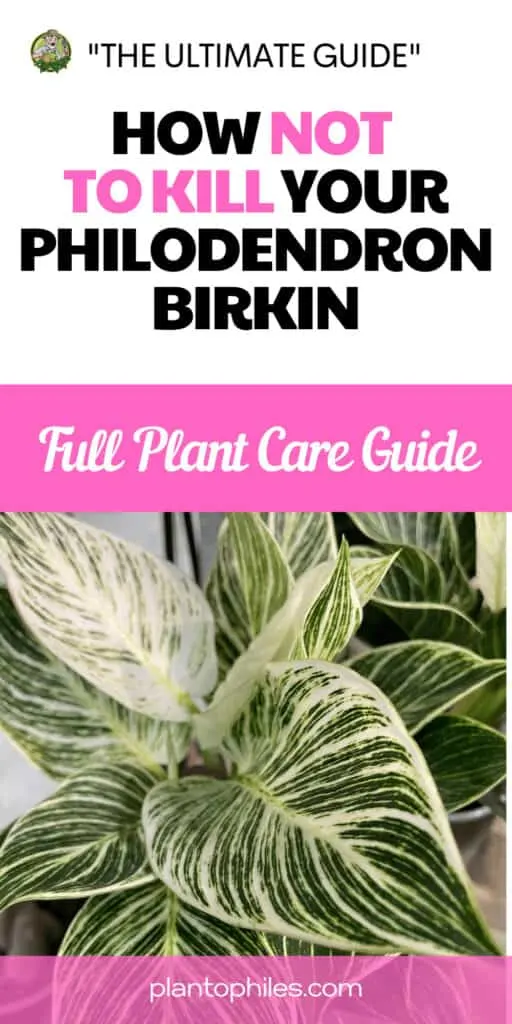
How much light does a Philodendron birkin need?
Philodendron birkin plants thrive in bright indirect light. Birkin Philodendrons need lots of light but indirect light.
You want to give your plant the feeling it’s under a tropical canopy. You have to mimic its natural habitat.
Direct sunlight for too long can cause leaves to start falling off and will burn the plant.
The plant will dry up fast and wilt away.
But too much shade is just as dangerous for your Birkin plant. It can cause too much space between the leaves and stems to start sagging.
Of course, this can lead to plant death as well.
So, if you place your Birkin plant on a window sill, place it in an east or west-facing window.
Artificial lights are another option. Instead of sitting your plant on a window sill, hoping it’s getting the right amount of sunlight.
It requires at least 12 hours of light during the day.
Your plant needs time to wind down in the dark. Plants are a lot like humans in that manner.
We recommend using grow lights for your Birkin plant in winter and every other season.
Once I started using a grow light for 12 hours a day, growth skyrocketed.
You only need to think about how to mount it. You can attach it to the ceiling or your bookshelf or frame.
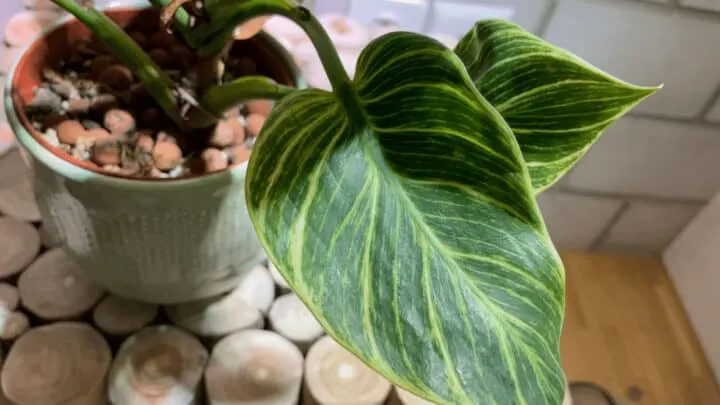
How often do you water a Birkin?
Water a Philodendron birkin once the top 2” of soil is dry (5cm) about once a week.
Like most plants, you want moist soil so your Philodendron birkin can soak the hydration.
But you also want to avoid over-watering your plant to avoid that dreaded wet feet. Avoid soggy soil as it leads to root rot.
So, you want to wait until the soil is mostly (but not all) dry before you water your Philodendron birkin.
The best way to check the moisture is to place your finger 2” (2.5cm) in the soil.
The soil that hits your knuckle and above should dry before watering the plant.
Try not to let the soil dry too much further below the soil, or it won’t get the water it needs to thrive.
Another way to tell is whether you have soil stuck to your finger when you pull it out of the pot. If there’s soil on your finger, it’s still moist enough and doesn’t need watering yet.
However, allow all the soil to dry during winter before you water the Birkin plant.
What is the ideal temperature for a Philodendron birkin?
A Philodendron birkin grows best at room temperature between 65°F and 75°F during the day (18°C – 24°C). It should be around 60F at night (16°C).
The Birkin does well in a warm and humid room since they’re tropical plants.
And the temperature of the room should never drop below 55F (13C).
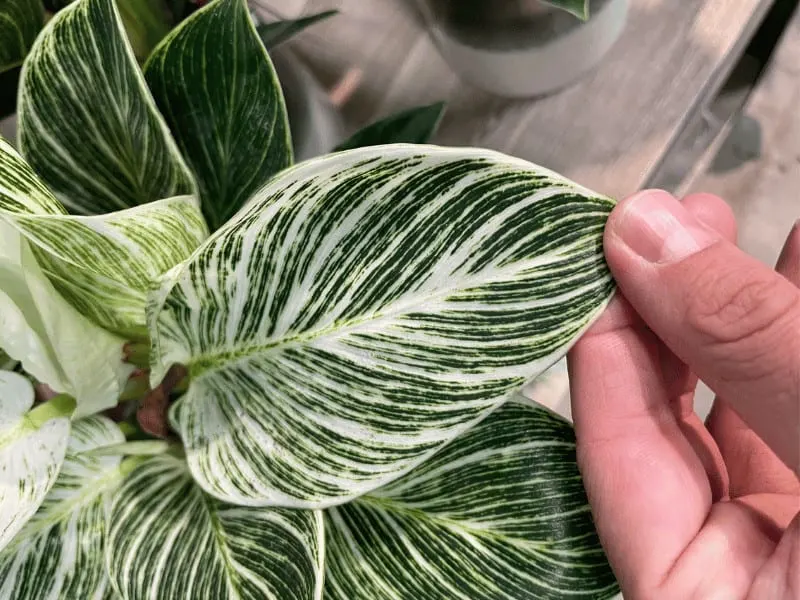
How much humidity does a Birkin need?
Keep humidity at 60% or higher for Philodendron birkin.
As we stated above, Philodendron birkin plants are tropical plants. They love, love humidity. It’s another way to mimic their natural environment.
They can live okay in light humidity. But the more humidity it has, the healthier the plant is. And the bigger the leaves on your plant will grow.
I am using a Levoit humidifier. It has a 1.5-gallon (6l) tank, so you do not have to refill it all the time, and it comes with a warm mist feature and remote control.
It is one of the purchases I made I do not regret. No more worrying if the humidity is sufficient for my Birkin and other tropical plants.
You can buy it at Amazon, and I linked it here for your convenience in case you are interested.
So, if possible, get that humidity in the room! You can also have a look at my full review of the best humidifiers for houseplants.
A pebbled tray is another popular way to create humidity for an indoor plant. Fill the tray with water and place your plant pot on the pebbles.
As the water evaporates, it creates humidity for your plant. And when the tray is empty, you can fill it up again.
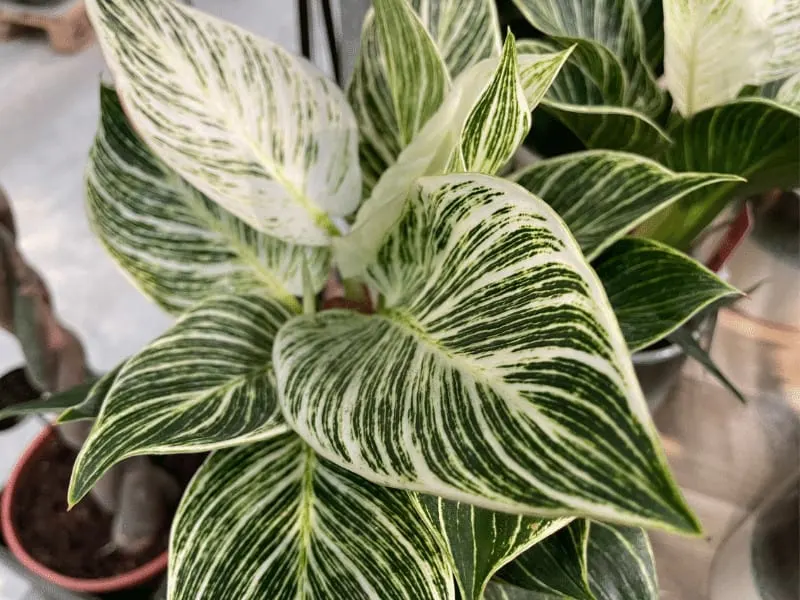
How often do your Fertilize a Birkin Philodendron?
Fertilizer is the key to a healthy Philodendron birkin with large beautiful leaves. Fertilize using a balanced liquid fertilizer once a month in spring and summer. Fertilize every other month in autumn and winter.
This liquid fertilizer should have micro-nutrients calcium and magnesium.
These are two of the most important nutrients for Philodendron plants.
Learn everything about fertilizing Philodendron birkin.
How to propagate a Philodendron birkin
The best way to propagate a Philodendron birkin is using stem cuttings. Cut a stem containing a node off your Philodendron birkin and place it in water, soil, or sphagnum moss.
In addition to stem cuttings, Birkin Philodendrons can be propagated using pups and by air layering. Read the three best ways to propagate Philodendron birkin in my in-depth article.
When to propagate a Philodendron birkin
You want to propagate a Philodendron birkin plant in spring during March or April.
Philodendron seeds won’t flower inside, so growing one straight from the seeds is impossible.
There are a couple of methods of propagating Birkin plants. But we’re going to share the two best methods.
Both methods need stem cuttings.
How to Propagate Philodendron birkin in Water
- First, get a stem cutting of your Birkin for water propagation. Cut a piece of stem that’s three to six inches in length. The longer, the better. Cut beneath a leaf node or a set of leaves. Don’t use a normal pair of scissors to cut your cuttings; use pruning shears instead.
- Pull the leaves off two leaf nodes that start from the bottom. You want these nodes bare.
- Fill a clear mason jar or a similar container with water. Make sure there’s an inch of space beneath the rim of the jar. Set the jar out overnight. This gives the chlorine in the water time to dissipate.
- The next day, place the stem cutting into the clear mason jar. The bare leaf nodes should sit in the water.
- You need to change the water every other day to keep the water clean and free from bacteria. In over a week, roots start to sprout from the bottom of the stem cutting.
- Once the roots are out, you want to move your stem cutting to where it can receive indirect bright light. That can be from the sun or grow lights.
- After the roots have grown an inch, you can move your growing Birkin plant to a pot. Be careful with the roots. You don’t want to tear them up.
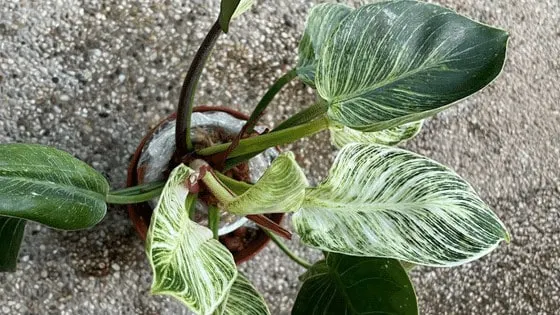
Propagation using the Air Layering Method
- First, you have to “wound” the stem. Take a sharp knife and make a cut two inches long. This cut should be in the center of your stem cutting.
- Take a toothpick and insert it into the wound you created. You want the toothpick to hold the wound open.
- Now you need damp sphagnum peat moss. A handful should be enough. Apply the peat moss around the wound. The moss has to be moist at all times. Whenever it starts to dry up, dampen it again. But only dampen, don’t soak the moss.
- Use a string to tie around the peat moss. This will hold it onto the wound.
- Wrap a square piece of polyurethane film around the peat moss on the stem. It must be tight against the moss and cover it all the way. There should be zero moss peaking out. Use duct tape to secure the film.
- About two weeks later, roots will grow out of the peat moss. This is when you can remove this stem from the rest of the Birkin plant. Cut right below the moss.
- Remove the film from the peat moss and roots. It’s time to plant it in a pot of soil. Be careful with the roots as you go through this process.
How large does Philodendron birkin grow?
Indoor Philodendron birkin plants can grow from 1.5 feet to 3 feet in height (45-90cm).
Philodendron birkin is a self-heading Philodendron, meaning it does not climb or crawl but grows a single upright head. It is a slow grower that does not need to be repotted often.

How to pot a Philodendron birkin?
Your Philodendron birkin plant’s growth rate determines how often you must re-pot it. When the roots have expanded as far as they can go in the bottom of your pot, it’s time to move them to a bigger one.
For some Birkin plants, that’s about a year. For others, it’s about two years.
When you pick out a new pot, ensure it’s not too much bigger than the previous pot. Too much space can stress out your plant. Choose pots with drainage holes for added drainage. Water needs to be able to evaporate quickly.
Read about how to repot Philodendron birkin.
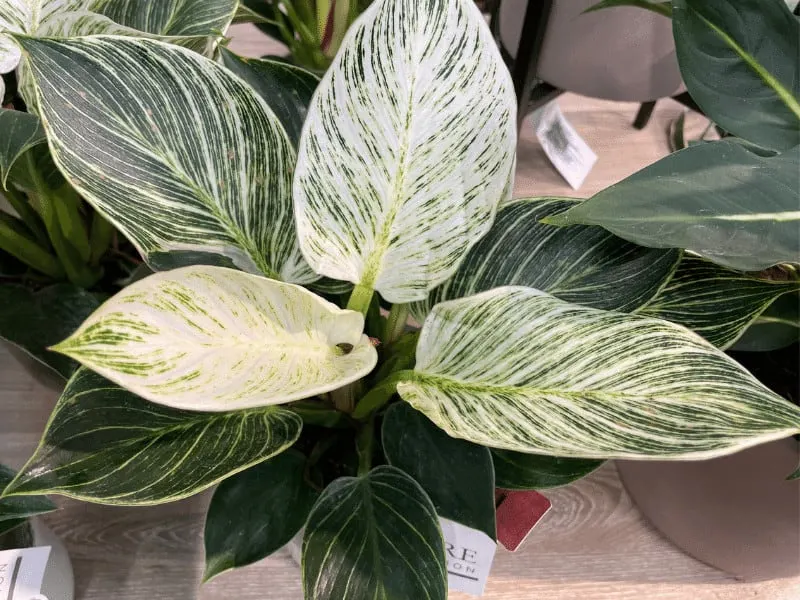
What is a Philodendron birkin?
The Birkin is a rare gorgeous houseplant with variegated dark green leaves and white pinstripes. The garden gods took a paintbrush across the leaves to make an intriguing pattern.
The tropical Philodendron birkin is part of the Araceae family. Philodendron is a species of the Aroid family of flowering plants. According to the University of Hawaii, the Araceae family comprises 110 genera and 1800 species.
Philodendron Varieties
There are other types of Philodendron plants outside of the Birkin.
And you can break Philodendron plants into two categories.
There are vine types and non-vine types of philodendrons.
Philodendron hederaceum
The Philodendron hederaceum is one of the most popular philodendrons because they’re the easiest to care for. They’re a vine type nicknamed “sweetheart” due to their heart-shaped leaves.
Philodendron brasil
Philodendron brasil another vine type of philodendron. The leaves are variegated, making them green, white, or cream-colored. Like the sweetheart plant, their leaves resemble hearts.
Philodendron xanadu
The Philodendron xanadu is a fun philodendron. This plant can grow pretty big if cared for the right way. The best part is that it’s almost as if the leaves have fingers hanging off them.
Philodendron moonlight
Philodendron moonlight is a hybrid Philodendron. It’s a bold, gorgeous green. It works just as well as an outdoor plant as it does indoors.
Philodendron white knight
I love the Philodendron white knight. The variegated leaves are a mix of brilliant green and spotless white. They’re unique and catch your eye while walking through your home.
Philodendron Birkin Pests and Dieseases
Spider Mites
Spider mites are one of the worst pests that invade Philodendron birkin plants.
These creepy mites are reddish-brown and super small. These infestations are hard to spot.
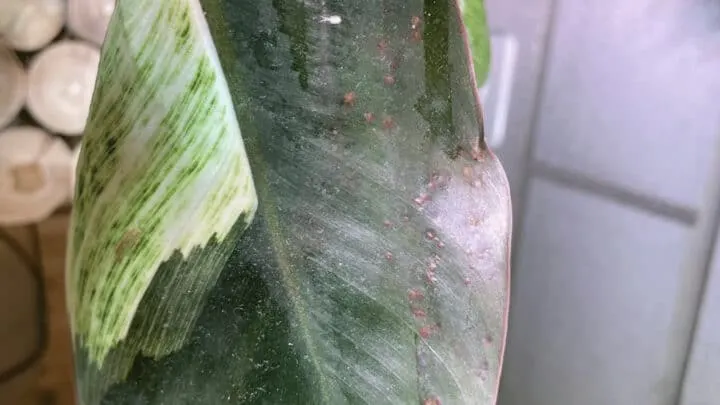
The spider mites suck up all your Birkin plant’s nutrients until there’s nothing left. They do this by biting the leaves and leaving light dot-shaped marks.
The leaves will dry and fall off when they’ve been feeding off a plant for a long time.
To eliminate spider mites, you must start by pruning the leaves and areas they have taken over.
You want to get every bit of those areas away from the parts of the plant that are still healthy. Use insecticidal soap to clean all your plants gently.
Do I have Thrips on my Birkin?
Thrips are another sneaky bug that loves Philodendron plants. Like most other plant bugs, they suck all the nutrients from your plant.
The bugs are very small with wings and hard to see unless you’re looking for them. They can be either pale yellow or black.
They like to feed in large groups. When they attack your plant, it will pale in color and turn splotchy. This can lead to plant death.
You can also use insecticidal soap to clean your plant off gently for these bugs. Any area that’s infested too badly should be removed.
Why does my Philodendron birkin have brown leaves?
When the leaves on a Birkin plant turn brown, it’s not getting enough humidity. Remember, these tropical plants need humidity to survive and thrive.
If you haven’t created a pebble tray, you’ll want to consider making one now. You can also mist the leaves every other day to create humidity for your plant.
Why does my Philodendron birkin have yellow leaves?
It doesn’t take long to see your plant’s leaves drying, yellowing, and falling off.
You’re over-watering your plant when leaves are yellowing around the edge and drying up.
Double-check your soil before you decide to water it next time. Make sure it’s dry.
If you have trouble with this, consider buying a moisture meter to track the soil’s moisture levels.
If small dots are on the leaves, your plant is infested with spider mites instead.
Why my Philodendron birkin has weird lesions and stinks?
If you find weird lesions on your stem, you’re in trouble. It’s the disease Erwinia blight (or fire blight). It’s a very common disease that attacks philodendron plants.
This disease takes only days to kill your plant and attacks under the soil. But you can save your plant if you catch it in time.
When this infection spreads, the branches start to sag and turn colors. You need a pair of pruning shears dipped in isopropyl alcohol to trim them.
Start cutting the branches off where they’re infected. The alcohol will help stop the infection from spreading to the areas that are still safe.
Why is my Philodendron birkin drooping?
A Philodendron birkin is drooping due to the following reasons:
- Overwatering
- Underwatering
- Cold
- It has a disease called fire blight or Erwinia Blight
Remedies:
- Overwatering: Change the soil, water less often
- Underwatering: Water regularly
- Cold: Change the spot
- It has a disease called fire blight or Erwinia Blight: Try a copper bactericide. Isolate the plant
Read more about why your Philodendron birkin is drooping and what to do.
Why is my Philodendron birkin dying?
If your Philodendron birkin is not living its best life and shows signs that it is unwell, it might be because of one of these four reasons:
- Root rot
- Dried out soil due to underwatering
- Too much sunlight
- Too much shade
- Transplant shock
Remedies:
- Root rot: Change the soil, disinfect the pot, cut off rotting roots, wash roots under running water
- Dried out soil due to underwatering: Water more and start slowly
- Too much sunlight: Use a curtain, or change the spot to a west- or east-facing window
- Too much shade: Use a grow light
- Transplant shock: Put the plant in a container with high humidity and make sure the plant is watered and fertilized
Read more about why your Philodendron birkin is dying here and how you can save your Birkin Philodendron.
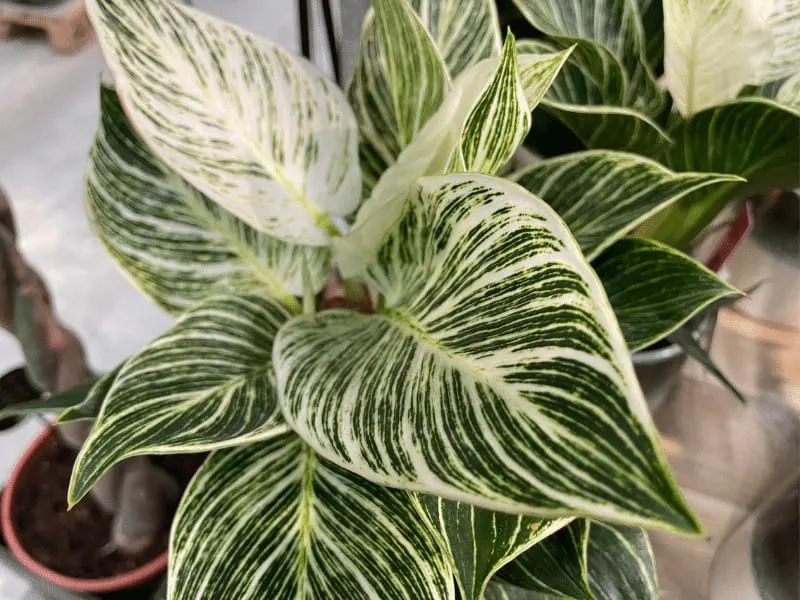
Where to Buy a Philodendron birkin?
You can buy a Philodendron birkin directly at Amazon or Etsy and even save yourself some money. Other shops selling birkins are Planterina and The Sill.
How much does a Philodendron birkin cost?
This Philodendron will cost between $20-$70 depending on the size and shop you are buying your plant.
Generally, smaller plants will cost less than larger Birkin plants with multiple leaves and a mature stem and root system. Prices have recently decreased as this plant becomes more readily available.
How rare is a Philodendron birkin?
Philodendron birkin can no longer be considered a rare plant as more and more plant shops and garden centers have started to stock this plant.
In 2020 and 2021, the demand for birkins skyrocketed, but supply has now caught up, and you shouldn’t have any problems finding this plant online and offline.
The Philodendron birkin Variegation
The variegation consists of beautiful white and yellow stripes. Unfortunately, the pinstripe variegation is unstable. This plant is a chimeric mutation originating from the Philodendron Congo Rojo.
There are several tips on how to get more white variegation on Philodendron birkin, such as controlling the level of sunlight temperature, watering, taking stem cuttings, and low-nitrogen fertilizer.
How big does a Philodendron birkin get?
The Birkin can get up to 3 feet tall (90cm) and grow up to 4 inches per week (10cm) in the growing season. The leaves will get up to 7 inches long on a mature plant (18cm). Birkin plants are fast growers.
This plant is not a climbing plant.
It is self-headed, meaning it does not trail and can support itself without a pole. However, a stake or moss pole can support the plant, and its aerial roots can be set into the pole for additional support.
What is the meaning of Philodendron Birkin?
The name consists of two-part. Philodendron is greek and means “tree lover.” Phileo for “to love” and dendron for tree.
Birkin is the name the chimeric mutation of the Philodendron Congo Rojo was given once discovered. It can be speculated that it got the name Birkin because the leaf stripes resemble those of a specific Birkin bag pattern.
Is Philodendron Birkin toxic?
Philodendron birkin plants are toxic to animals such as dogs and cats and are mildly toxic to humans. They contain a high amount of calcium oxalate crystals according to ASPCA.
Your cat or dog could die from ingesting a lot of a Philodendron plant. Smaller amounts can still make your cat very, very ill. The oxalate chrystals can lead to skin irritations, diarrhea and vomiting
My Philodendron birkin is reverting. What can I do?
When your Philodendron birkin is reverting, cut it back a few nodes to where it showed the most variegation.
The plant will develop a new top and continue to grow. Chances are that the variegation will come back. You can cut it back multiple times, and chances are that the variegation will improve.
What is the origin of Philodendron birkin?
The Philodendron birkin is a chimeric mutation of the Philodendron Congo Rojo. This means a Philodendron Congo Rojo started producing variegated leaves with the signature white pinstripes.
This mutation was then multiplied to produce the Birkins we know today. Sometimes you will see reddish, and burgundy leaves as completely green leaves emerge on the plant. This is in remembrance of its heritage and the Congo Rojo shining through.
Frequently Asked Questions
What kind of water should I use when I water my Philodendron birkin?
There’s no specific water to use for a Philodendron birkin. But if you use tap water, there are a few things you need to keep in mind. Let the water sit out overnight so the chlorine can dissipate. Make sure this water is lukewarm so it doesn’t shock your plant.
How do I get rid of spider mites on Philodendron birkin forever?
Check your plant often for dust and clean off the leaves as needed. Use neem oil and apply it weekly on the leaves of the plant.
Does Philodendron birkin have vines?
Birkin plants don’t have vines. But several other types of philodendron plants do have vines.
Can my Philodendron birkin plant hurt my cat?
Philodendron birkin plants contain a high amount of calcium oxalate crystals. Calcium oxalate is toxic to both humans and animals. Your cat could die from ingesting a large amount of a philodendron plant. Smaller amounts can still make your cat very, very ill.
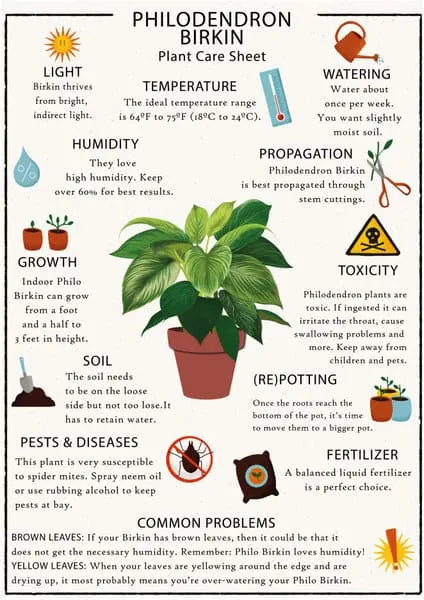
Conclusion About Philodendron birkin Care
To care for Philodendron birkin use a well-draining aroid potting mix. The ideal temperature is 65 -75°F (18-24°C). Provide humidity >60% and water once the top 2-3 inches of soil are dry. Fertilize bi-weekly during the main growth period in spring and summer and revert to monthly in autumn and winter.

Daniel has been a plant enthusiast for over 20 years. He owns hundreds of houseplants and prepares for the chili growing seasons yearly with great anticipation. His favorite plants are plant species in the Araceae family, such as Monstera, Philodendron, and Anthurium. He also loves gardening and is growing hot peppers, tomatoes, and many more vegetables.

![Philodendron Birkin Care – My Best Guide [2023]](https://plantophiles.com/wp-content/uploads/2020/05/Philodendron-birkin-with-intense-variegation-728x410.jpg.webp)
